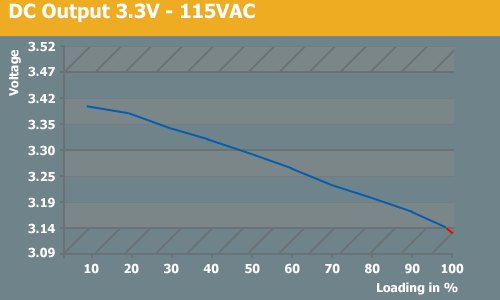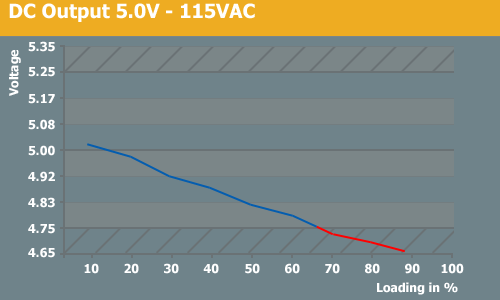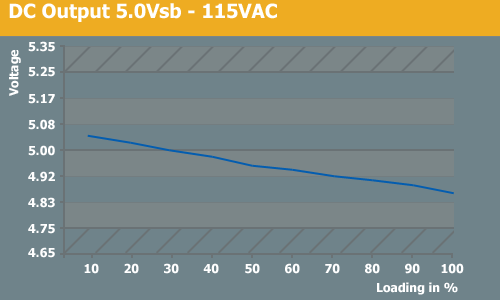The Single 12V Rail SilverStone Olympia OP650
by Christoph Katzer on July 13, 2007 12:00 PM EST- Posted in
- Cases/Cooling/PSUs
Testing
We have already described our test setup and methodology here. Due to increasing heat the lower voltage rails will most likely decrease in output. This results from the tremendous ambient temperature in which we are testing power supplies and does not necessarily reflect what you will have in your PC at home. This is essentially a worst case test with respect to heat, and if the PSU performs well in our environment, you can be assured it will perform well in your PC. We are testing with 115VAC and 230VAC to cover all markets. To make the voltage drop more visible we will include graphs instead of tables. Above and below the dashed lines are out of spec values. Everything within these lines is within the specs and therefore acceptable.
To properly load the power supply we are using a Chroma DC Load. In this way we are able to put a specific amount of load on each of the connected rails. We are testing in ten steps beginning with 10% load and ending with 100% of each power supply's maximum output. The total procedure is taking us 5 hours for each of the two input voltages.
115VAC 3.3V, 5V, and 5Vsb Tests
The lower voltage rails have dropped hard during the test and they went under specification at about 80-90% of load. The 5v rail dropped under spec at around 65% load. With 230VAC things looked a little better. This could have been partly because we tested 230V first and the power supply might have been sweating it.



We have already described our test setup and methodology here. Due to increasing heat the lower voltage rails will most likely decrease in output. This results from the tremendous ambient temperature in which we are testing power supplies and does not necessarily reflect what you will have in your PC at home. This is essentially a worst case test with respect to heat, and if the PSU performs well in our environment, you can be assured it will perform well in your PC. We are testing with 115VAC and 230VAC to cover all markets. To make the voltage drop more visible we will include graphs instead of tables. Above and below the dashed lines are out of spec values. Everything within these lines is within the specs and therefore acceptable.
To properly load the power supply we are using a Chroma DC Load. In this way we are able to put a specific amount of load on each of the connected rails. We are testing in ten steps beginning with 10% load and ending with 100% of each power supply's maximum output. The total procedure is taking us 5 hours for each of the two input voltages.
115VAC 3.3V, 5V, and 5Vsb Tests
The lower voltage rails have dropped hard during the test and they went under specification at about 80-90% of load. The 5v rail dropped under spec at around 65% load. With 230VAC things looked a little better. This could have been partly because we tested 230V first and the power supply might have been sweating it.













46 Comments
View All Comments
Martimus - Friday, July 13, 2007 - link
It was a nice article. I know not to buy this PSU now when I build my roommates computer later this month. I don't like how it falls out of spec at high loads. I would like to see a review on the PC P&C 750W Silencer Quad, as that was what I was planning on using for his computer.Looking at that board frightened me, seeing as how much power was in that supply, and how close together the components were. I hope that they can increase the size of the standard power supply to help alleviate this problem now that we are building computers that have such high loads. I used to design and test power supplies (albeit for automotive conponents) and seeing how they crammed those parts so close together was scary. That is an easy way to kill the reliability and life of your supply. The heat just kills the board and components. Although it does reduce problems like parasitic capacitance. Maybe that is why many manufactures are avoiding using the top mounted 120mm fan; to keep from having to package the component like that.
yacoub - Friday, July 13, 2007 - link
But doesn't that mean the motherboard will need to use its little battery backup to keep the BIOS settings? Turning off the PSU switch and/or unplugging the cable to fully remove power sounds like a way to kill your motherboard's battery quickly.
mindless1 - Wednesday, July 18, 2007 - link
It is only a "suggestion", there is just as valid an argument to not unplug it unless you're on a quest to save every last bit of power possible which is a nobile goal but put in perspective, a bit of a band-aid since anyone using a modern computer to access webpages is wasting orders of magnitude more power, even ignoring the typical products with large power consumption.It might be said that unplugging also provides some protection against surges, limiting exposure to them, but it's really something that would have to be considered on a per-site basis, remembering that most people don't unplug their computers any day of the year and seldom is surge damage a recurring problem. IOW, a matter of how much extra effort to put forth to guard against something that, statistically, isn't likely to happen.
DerekWilson - Friday, July 13, 2007 - link
iirc, your mobo battery is in use when the computer is off and the PSU is on anyway. i could be wrong ... its been like a decade since i paid attention to that.But either way, mobo batteries last years even when their not powered up.
SpaceRanger - Friday, July 13, 2007 - link
Very nice work on AT's first PSU review with such detail. One question though, what happened to the Ripple and Noise results from the PSU? In the methodology they were mentioned to be tested, yet not in this review?Looking forward to more PSU reviews..
Shadowmage - Friday, July 13, 2007 - link
I agree. The reviews must have ripple. That's why Jonnyguru's reviews are so highly regarded.mindless1 - Wednesday, July 18, 2007 - link
and yet, we don't really need to know the ripple values so long as they stay within ATX specs at the max rated loads and all crossloading combinations possible. Within these limits, lower ripple is not necessarily "better" per se, if it were important to have lowest possible ripple we wouldn't be using switching PSU at all or they'd at least have an addt'l stage of LC filtration before the output.LTG - Friday, July 13, 2007 - link
The first page leaves out an explanation of why multiple rails are used in the first place.I'm sure many technical software people, who don't know hardware, wonder like I do, why wasn't it always just one rail?
Just a couple sentences would probably be helpful.
thanks.
qpwoei - Friday, July 13, 2007 - link
A PSU having multiple rails just means that a single rail in the PSU runs through a number of parallel current limiters - so all lines on the 12V1 rail go through one 20A current limiter, all lines on 12V2 go through another, etc. This is done as IEC safety requirements (and consequently ATX PSU requirements) say that "operator accessible" connections must not be able to deliver more than 240 VA (ie: 20 A at 12 V).In older PSUs, only a single current limiter was used as there was no requirement for maximum current per line. In many recent PSUs, the single current maximum is starting to come back as well due to the high current requirements of modern GPUs and motherboards.
mindless1 - Wednesday, July 18, 2007 - link
While it is common (because it's cheaper to implement) for a 12V multi-rail PSU to use parallel current limiters, it is not necessarily true that all are designed this way, typically only those built towards lower component cost instead of higher sustainable current. Other options include having separate capacitance after the current limiter (resistor), or a second inductor-cap LC stage, or additionally a separate rectifier stage, or additionally a separate transformer (essentially going backwards towards building in a 2nd supply until available space and budget limit it).